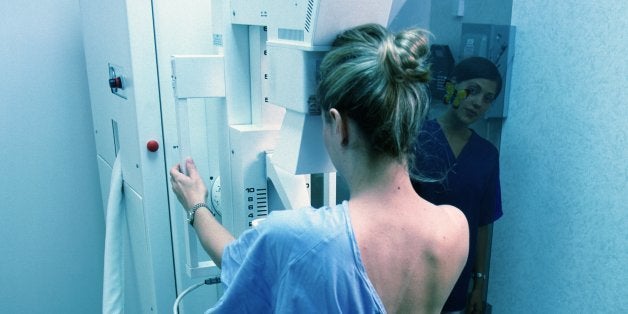
Not only do our breasts come in pairs, women tend to do things in pairs.
That's because we find comfort in doing things in pairs.
So, when you've spent a lifetime doing things in pairs and only one of you gets cancer, that once-balanced seesaw tips and the tears fall. You cannot ever know, understand or begin to fathom your friend's struggle.
The "pair-thing" starts at a young age. In actually, it started thousands of years ago.
"Traveling in packs is comforting and evolutionary," says Dr. Deborah Mulhern, a Washington, D.C. area psychologist and expert in interpersonal neurobiology. "In cave women times, women tended to bond together as a survival strategy. This offered the greatest advantage for the group. So, for them awareness of fear was a good motivator for joining together to confront a threat or protect their offspring."
"Joining together to confront a threat" was the very reason that every year since I was 40, to calm fears and get to the radiologist, my very good friend, Lisa Gemelli Frost, and I paired up for our yearly mammogram appointment. She was already an "expert." With a family history of breast cancer, she'd been getting yearly mammograms since her late 20s. We were "Thing 1" and "Thing 2" and we brought in our "Thing 1's and 2's" to be checked out.
Until one day her "girls" set off alarm bells.
Putting her breast up on the plate to be squeezed, the technician reacted with mild concern: "That doesn't feel right," she told Lisa. "You have a mass in your breast."
The mammogram produced minutes later showed nothing.
The technician, however, told my friend that in all good conscience, she could not let her leave without a diagnostic mammogram. A mammogram is just a screening; a diagnostic is much more than that. The doctor ordered the diagnostic. Then the doctor ordered an ultrasound. It was ultrasound that showed a large tumor and abnormal lymph nodes.
The tumor had been growing for years; and, for years her mammograms had ignored the unwelcome and insidious invader.
Until very recently, Lisa's story is a lesson that was not taught in doctor's offices: If you have a family history of breast cancer and you have been told that you have "dense" breast tissue, mammograms are not enough. Patients should be talking to their doctors and their insurance companies about MRIs and Ultrasounds. Mammograms are just simply not enough in these cases. It should be, in fact, the "new standard" of care.
"I want women to know that it is OK to ask their doctors to take a step beyond what they normally do," says Lisa who, three years later, is still suffering from negative side effects of the drugs and treatments that followed her double mastectomy, five months of weekly chemotherapy and six weeks of daily radiation. "I implore women to take their health into their own hands. Don't assume that all doctors are up to date on what is best for your health," Lisa told me emphatically.
Doctors in some states, such as New York, began posting signs in their waiting rooms letting women know that if their health practitioner tells them they have dense breast tissue, they may require further testing. "This needs to be everywhere!" Lisa exclaimed. The law in New York was signed into effect exactly two years ago in July 2012 by Governor Cuomo.
So, why isn't this law everywhere? And why has it taken until the 21st Century to make it into only some doctor's offices. It doesn't make sense, especially when Lisa's story is, sadly, a story told over and over:
Hallie Leighton has a similar story to my friend Lisa's, as does Dr. Nancy Cappello, and this woman, who wrote her story on the website, Are You Dense.
What I don't understand is how it can be, over and over again, the same story for thousands of women who diligently received mammograms when mammograms could do nothing to warn them of their growing masses. Like my friend, many of these women went to their doctors, pointing out the unusual density in their breasts only to be dismissed when a machine gave them a "clean bill of health."
By the time they found Lisa's mass, my friend's tumor was more than half the size of her breast. To get rid of the massive invader, Lisa endured a three-hour operation that included removal of her tumor-filled breast as well as the other breast that, as it turns out, was growing its own cancer mass. 30 lymph nodes were removed as well; biopsies showed that 24 of them were cancerous. According to cancer specialists, if more than five lymph nodes are contaminated with cancer, treatment becomes aggressive.
An additional six hours of reconstructive surgery on breast number one was followed by two failed rounds of reconstructive surgery on breast number two. The complications from the failed reconstructions sent her into a physical, not to mention emotional, tailspin.
The seesaw had tipped; my friend was slammed painfully to the ground without warning, though she'd been so careful to stay balanced. Family and friends rallied behind Lisa's positive, "there's-no-way-in-Hell-this-is-going-to-take-me-down" attitude and began in earnest trying to make her world even again. Her four daughter's clung tight.
A tipping seesaw is never fair. But my friend never complained.
My friend's seesaw is now tipping back. Her smile remains on her face; it never left -- at least not publicly. Her hair grew in: first biker-chick chic, then a short fashionable look, and now back to the beautiful length she'd sported before cancer took over her life. She endured itching hands, premature menopause ripe with severe hot flashes and heat intolerance and joint pain from hormonal therapy. Chronic lymphedema and neuropathy in her dominant hand and pain and tendon issues in both of her hands. And those are just physiological side effects.
Three years after a double mastectomy that literally left her body flattened, Lisa's spirit has remains just as large as her former double D's. She has harnessed the negative energy that consumed her for three years and she is now on a mission to warn other women.
Read her stories from then, http://www.caringbridge.org/visit/lisagemellifrost, and now http://www.curediva.com/blog/author/Lisa+Frost/
